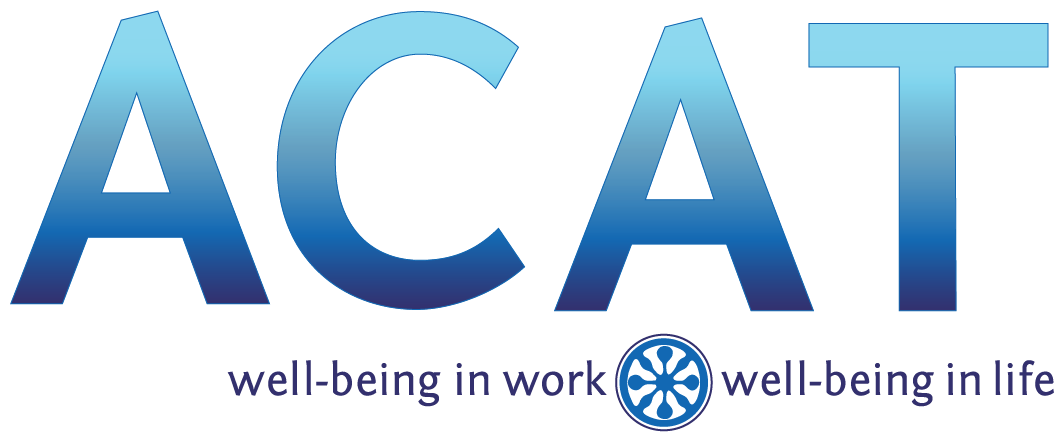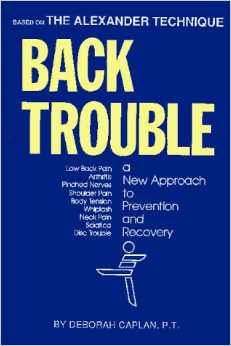Click here to purchase Back Trouble for Kindle.
by Judy Stern and Jessica Santascoy Deborah "Debby" Caplan, author of "Back Trouble: A New Approach to Prevention and Recovery," was a physical therapist and taught the Alexander Technique for over 50 years. She was a founding member of the American Center for the Alexander Technique (ACAT) and a senior faculty member.
Judy Stern, a faculty member of the ACAT Teacher Certification Program and a teacher with almost 30 years experience, was more than impressed by her cousin's recovery from excruciating back pain after taking Alexander lessons with Debby Caplan. At that time, Judy had been a practicing physical therapist for 18 years, and was excited by the possibilities of pain relief that the Alexander Technique offered. Within four years of her cousin's life-changing course of lessons, Judy moved from Gainesville, Florida to New York City to study the Technique herself, and she was mentored by Debby.
SANTASCOY
Why do you give "Back Trouble" to your students when they have a first lesson with you?
STERN
Back Trouble is a basic Alexander text easily read and understood by anyone who wants clear, accurate medical information and is struggling with back issues. I often say at the end of the first lesson that "everything I have taught you today is explained in the first 4 chapters of this book.” I then ask my students to go home a read those chapters.
I believe that learning should be addressed through multiple channels—ie: the visual sense - reading and video, the auditory sense - verbalization, and the kinesthetic sense - touch—to achieve the most effective introduction to the Alexander Technique. I also use the photos in Debby’s book as teaching tools, and let students know that many of the questions people ask about, including the efficacy of the Alexander Technique, are directly answered in the book.
SANTASCOY
What's an essential part or paragraph of the book and why? In other words, what do you think is important for students to remember from this book?
STERN
This is a challenging question!
I believe this book offers the public a basic understanding of the anatomy and physiology of musculoskeletal pain and explains the efficacy of addressing problems with the principles of the AT.
I first saw this book in manuscript form when Debby was writing it, and threatened to “steal” the chapters on back and neck pain for my physical therapy patients, if she didn’t publish it. I am the Judy Trobe (now Stern) who Debby mentions in the acknowledgments, and I was deeply influenced by Debby.
I am partial to Chapter 5 - "Low Back Pain," and Chapter 3 - "Concepts of Good Use." They are both clear, concise explanations of challenging subjects we Alexander teachers are confronted with explaining daily. I also like chapter 9, Emergency Treatment of the Back.
If I had to choose a section to quote from, it would be "Eliminating Tension":
“Learning to do less with the body is one of the most useful aspects of Alexander’s work for back sufferers. Doing less does not mean being less active, but rather, eliminating all the unnecessary muscle tension and harmful postural habits that can cause, and prolong, back pain.
"As you begin learning to eliminate unnecessary muscle tension, you will be able to stop the tension cycle that invariably accompanies back problems. This cycle occurs because pain causes more tension, which in turn causes more pain, and so on. Many of my patients have found that by using the Alexander Technique they are able to stop this painful cycle themselves and thus avoid taking muscle relaxants and painkillers. They also feel more energetic, since they are not using so much of their energy in the form of unnecessary muscle tension.” (Caplan, 14)
SANTASCOY
The Technique is practical, and helps people change everyday habits. How does "Back Trouble" complement AT lessons?
STERN
Debby was a master at teaching people to apply the AT to daily life. This wisdom can be found on pages 75-79, "Applications To Daily Life," and in Chapter 7, "Positions We All Get Into." The illustrations say everything about what working with ease and better use "looks like." The explanations are simple and clear for the general public (no Alexander Technique jargon). Sitting, standing, and walking are the basic activities of life we all address when teaching the Alexander Technique. Debby addresses them all in these parts of her book.
JUDY STERN was a senior faculty member at the American Center for the Alexander Technique (ACAT). She taught the Alexander Technique for over 30 years. She has a post-graduate certificate in Physical Therapy and a Master of Arts in Health Education from the University of Florida/Gainesville. She was a member of the faculty at the University of Pennsylvania School of Physical Therapy early in her career, and worked for 19 years as a traditional physical therapist. Judy has a special interest in the neurophysiology of the Technique. She has retired from private practice.
JESSICA SANTASCOY is an Alexander Technique teacher specializing in the change of inefficient habitual thought and movement patterns to lessen pain, stress, anxiety, and stage fright. She effectively employs a calm and gentle approach, understanding how fear and pain short circuit the body and productivity. Her clients include high level executives, software engineers, designers, and actors. Jessica graduated from the American Center for the Alexander Technique, holds a BA in Psychology, and an MA in Media Studies. She teaches in New York City and San Francisco. Connect with Jessica via email or on Twitter @jessicasuzette.






